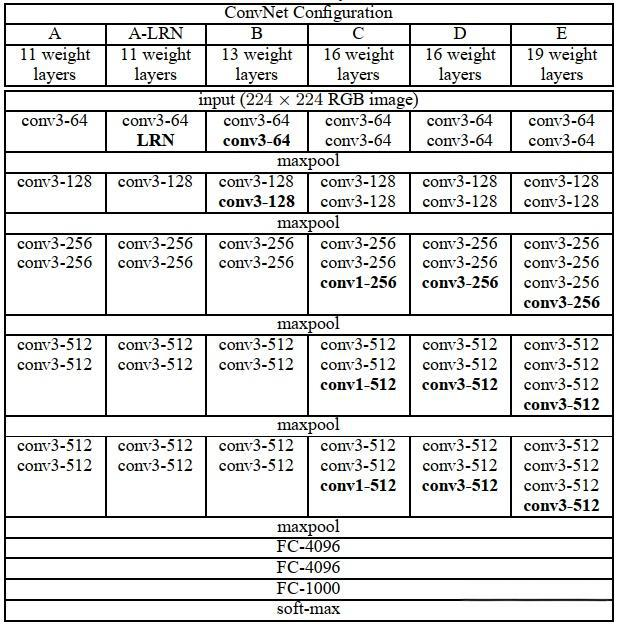网络背景
VGG网络是由牛津大学 Visual Geometry Group(视觉几何组)的研究团队在2014年提出的经典卷积神经网络架构,其全称为 VGGNet。它在当时(2014年)的 ImageNet Large Scale Visual Recognition Challenge (ILSVRC) 竞赛中取得了优异的成绩,并因其简洁、统一的架构设计成为深度学习计算机视觉领域的重要里程碑。
网络创新
1.统一使用小卷积核代替大尺度卷积核
所有卷积层均采用 3×3小卷积核(stride=1, padding=1),替代AlexNet中的大卷积核(11×11、5×5)。两个3×3卷积堆叠的感受野相当于一个5×5卷积,但参数量更少;三个3×3卷积堆叠的感受野相当于一个7×7卷积,参数量也更小。
2.对深度网络进行探索
VGG团队设计了从 VGG11(11层)到 VGG19(19层)的多个变体,严格保持其他超参数一致,首次系统化研究深度对性能的影响。更深的网络能学习更复杂的特征层次(从边缘→纹理→物体部件→整体对象),但超过19层后,梯度消失问题凸显。
3.严格的架构规范化
所有卷积层使用相同配置(3×3卷积+ReLU),池化层仅用 2×2 MaxPool(stride=2),结构高度统一。可复现性强,迁移学习友好。
网络结构

以VGG16为例:
输入层 (224×224×3 RGB图像)
↓
卷积层1 (64个3×3卷积核) → ReLU → 最大池化 (2×2)
↓
卷积层2 (128个3×3卷积核) → ReLU → 最大池化 (2×2)
↓
卷积层3 (256个3×3卷积核) → ReLU
↓
卷积层4 (256个3×3卷积核) → ReLU
↓
卷积层5 (256个3×3卷积核) → ReLU → 最大池化 (2×2)
↓
卷积层6 (512个3×3卷积核) → ReLU
↓
卷积层7 (512个3×3卷积核) → ReLU
↓
卷积层8 (512个3×3卷积核) → ReLU → 最大池化 (2×2)
↓
卷积层9 (512个3×3卷积核) → ReLU
↓
卷积层10 (512个3×3卷积核) → ReLU
↓
卷积层11 (512个3×3卷积核) → ReLU → 最大池化 (2×2)
↓
展平 (Flatten)
↓
全连接层12 (4096神经元) → ReLU → Dropout (0.5)
↓
全连接层13 (4096神经元) → ReLU → Dropout (0.5)
↓
全连接层14 (1000神经元) → Softmax
↓
输出层 (1000类概率)
网络代码
import torch.nn as nn
import torch
class VGG(nn.Module):
def __init__(self, features, num_classes=1000, init_weights=False):
super(VGG, self).__init__()
self.features = features
self.classifier = nn.Sequential(
nn.Linear(512*7*7, 4096),
nn.ReLU(True),
nn.Dropout(p=0.5),
nn.Linear(4096, 4096),
nn.ReLU(True),
nn.Dropout(p=0.5),
nn.Linear(4096, num_classes)
)
if init_weights:
self._initialize_weights()
def forward(self, x):
# N x 3 x 224 x 224
x = self.features(x)
# N x 512 x 7 x 7
x = torch.flatten(x, start_dim=1)
# N x 512*7*7
x = self.classifier(x)
return x
def _initialize_weights(self):
for m in self.modules():
if isinstance(m, nn.Conv2d):
# nn.init.kaiming_normal_(m.weight, mode='fan_out', nonlinearity='relu')
nn.init.xavier_uniform_(m.weight)
if m.bias is not None:
nn.init.constant_(m.bias, 0)
elif isinstance(m, nn.Linear):
nn.init.xavier_uniform_(m.weight)
# nn.init.normal_(m.weight, 0, 0.01)
nn.init.constant_(m.bias, 0)
def make_features(cfg: list):
layers = []
in_channels = 3
for v in cfg:
if v == "M":
layers += [nn.MaxPool2d(kernel_size=2, stride=2)]
else:
conv2d = nn.Conv2d(in_channels, v, kernel_size=3, padding=1)
layers += [conv2d, nn.ReLU(True)]
in_channels = v
return nn.Sequential(*layers)
cfgs = {
'vgg11': [64, 'M', 128, 'M', 256, 256, 'M', 512, 512, 'M', 512, 512, 'M'],
'vgg13': [64, 64, 'M', 128, 128, 'M', 256, 256, 'M', 512, 512, 'M', 512, 512, 'M'],
'vgg16': [64, 64, 'M', 128, 128, 'M', 256, 256, 256, 'M', 512, 512, 512, 'M', 512, 512, 512, 'M'],
'vgg19': [64, 64, 'M', 128, 128, 'M', 256, 256, 256, 256, 'M', 512, 512, 512, 512, 'M', 512, 512, 512, 512, 'M'],
}
def vgg(model_name="vgg16", **kwargs):
assert model_name in cfgs, "Warning: model number {} not in cfgs dict!".format(model_name)
cfg = cfgs[model_name]
model = VGG(make_features(cfg), **kwargs)
return model
网络局限性
1. 参数量过大,计算成本高
VGG-16的全连接层(FC-4096 → FC-4096 → FC-1000)占用了约 1.2亿参数(占总参数量的80%以上),导致模型体积庞大(如VGG-16的预训练模型超过500MB)。
2.存在梯度消失/爆炸问题
网络深度达16~19层,但未使用残差连接(ResNet)或批量归一化(BatchNorm),导致梯度反向传播时容易衰减或发散,训练不稳定。
























 481
481

 被折叠的 条评论
为什么被折叠?
被折叠的 条评论
为什么被折叠?








